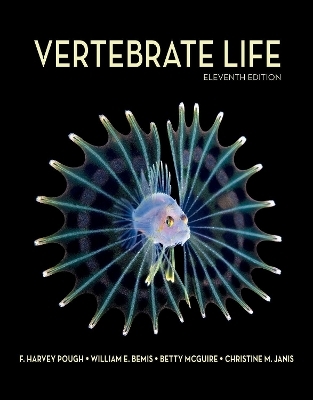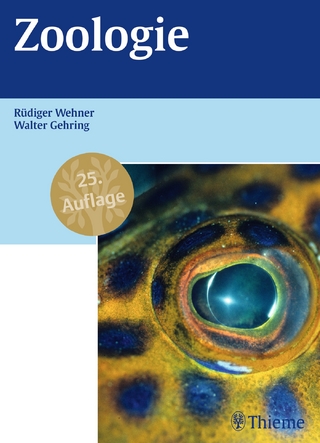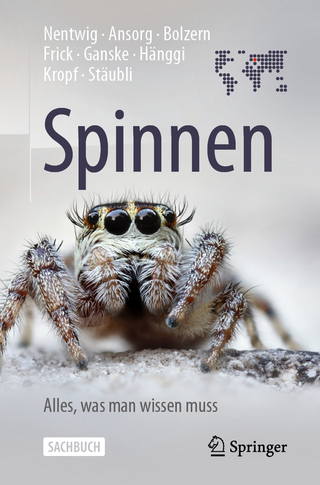
Vertebrate Life
Oxford University Press Inc (Verlag)
978-0-19-755862-1 (ISBN)
Vertebrate Life distills the necessary information from vertebrate anatomy, physiology, ecology, and behavioral studies and then helps students see important connections across levels of biological scale. The result is students come to understand how organisms function effectively in their environments and how lineages of organisms change through evolutionary time. Processing complex detailed information about expansive phylogenies and diverse anatomies can be difficult for even the most motivated students, and Vertebrate Life addresses this challenge by combining appropriately-detailed, clearly-written text with outstanding phylogenies and figures, making it a thorough and engaging reference for students and instructors alike. The text's impressive illustration program helps students visualize complex concepts, allowing them to parse difficult anatomical information. The 11th edition will have an upgraded illustration program with several new and revised figures, including layered figures presented in the new enhanced eBook.
F. Harvey Pough, Professor Emeritus at Rochester Institute of Technology, is a herpetologist, specializing in environmental and evolutionary physiology, a past president of the American Society of Ichthyologists and Herpetologists, and the senior author of textbooks on Herpetology and Vertebrate Zoology. He has taught courses in Animal Behavior, Ecology, Herpetology, Human Biology, Introductory Biology, Physiological Ecology, and Vertebrate Zoology. William E. Bemis is Professor of Ecology and Evolutionary Biology at Cornell University and Faculty Curator of Ichthyology at the Cornell University Museum of Vertebrates. He has studied the anatomy, systematics, and evolution of extant and fossil vertebrates for 50 years with a focus on fishes. He currently teaches Vertebrate Biology, Ichthyology, and Herpetology. Betty McGuire is a retired Senior Lecturer from the Department of Ecology and Evolutionary Biology at Cornell University. She has studied social behavior, reproduction, and ecology of small mammals and currently studies behavior of domestic dogs. She coauthored textbooks on Animal Behavior and Human Biology, and taught courses in Vertebrate Biology, Mammalogy, Human Biology, Animal Behavior, Evolution, and Introductory Biology. Christine M. Janis is Professor Emerita at Brown University, USA, and currently an Honorary Professor at the University of Bristol, UK. She is a mammalian paleobiologist who has studied the feeding and locomotion of Cenozoic mammals, especially ungulates (hoofed mammals) and kangaroos, and their paleobiology in the context of climatic and environmental change. She has taught courses in Comparative Anatomy and Vertebrate Paleontology.
Preface xv
Chapter 1
Diversity, Classification, and Evolution of Vertebrates
1.1 The Vertebrate Story
--Binominal nomenclature
--Extant vertebrate groups
1.2 Phylogenetic Systematics
1.3 Applying Phylogenetic Criteria
--Evaluating possible phylogenies
--Molecules and morphology
--The problem of dating
--Dagger (DR) convention adopted in this book
1.4 Using Phylogenetic Trees
--Extant phylogenetic brackets
--Paraphyly
--Crown and stem groups
1.5 Genetic Mechanisms of Evolutionary Change
--Phenotypes and fitness
--Developmental regulatory genes
1.6 Epigenetic Effects
1.7 Earth History and Vertebrate Evolution
Chapter 2
What Is a Vertebrate??
2.1 Vertebrates in Relation to Other Animals?
2.2 Characteristics of Chordates?
--Chordate origins and evolution?
--Extant nonvertebrate chordates?
2.3 What Distinguishes a Vertebrate??
2.4 Vertebrate Embryonic Development?
--Development of the body?
--Development of the pharyngeal region?
--Development of the brain?
--Other neurogenic tissues of vertebrates?
2.5 Vertebrate Tissues?
--Adult tissue types
--Mineralized tissues
2.6 Vertebrate Organ Systems
--Integumentary system
--Skeletal system
--Muscular system
--Nervous system and sense organs
--Endocrine system
--Respiratory system
--Circulatory system
--Digestive system
--Excretory and reproductive systems
Chapter 3
Jawless Vertebrates and the Origin of Gnathostomes
3.1 Earliest Evidence of Vertebrates
--Enigmas: DRConodonts and DRTullimonstrum
---Early mineralized tissues
--Environment of early vertebrate evolution
3.2 Cyclostomes: Extant Jawless Vertebrate
--Characters of cyclostomes
--Hagfishes: Myxiniformes
--Lampreys: Petromyzontiformes
3.3 Jawless Osteognathostomes
3.4 Gnathostome Body Plan
--Gnathostome skeletons
--What about soft anatomical features?
3.5 Origin of Jaws
--Hypotheses of jaw origins
--Importance of the nose
--Selective value of jaws
3.6 Origin of Paired Appendages
--Fin development and the lateral somitic frontier
--Advantages of fins
3.7 Extinct Paleozoic Jawed Fishes
Chapter 4
Living in Water
4.1 Aquatic Environment
--Obtaining oxygen from water using gill
--Obtaining oxygen from air using lungs and other respiratory structure
--Adjusting buoyancy
4.2 Sensory World of Aquatic Vertebrates
--Vision
--Chemosensation: Olfaction and taste
--Detecting water displacement
--Hearing and equilibrium
--Electroreception and electrogenesis
4.3 Maintaining an Internal Environment
--Nitrogenous wastes and kidney
--Osmoregulation
--Regulation of ions and body fluids
4.4 Osmoregulation in Different Environments
--Marine cartilaginous fishes and coelacanths
--Marine teleosts
--Freshwater teleosts and lissamphibians
--Euryhaline vertebrates
Chapter 5
Geography and Ecology of the Paleozoic
5.1 Deep Time
--The Precambrian world
--The Paleozoic
5.2 Continental Geography
--Continental drift and plate tectonics
--Shifting continents of the Paleozoic
--Shifting continents and changing climates
5.3 Paleozoic Climates
5.4 Paleozoic Ecosystems
--Aquatic life
--Terrestrial flora
--Terrestrial fauna
5.5 Extinctions
Chapter 6
Origin and Radiation of Chondrichthyans
6.1 Acanthodii
6.2 Chondrichthyes
--Habitats and diversity
--Placoid scales
--Cartilaginous skeleton
--Teeth and tooth plates
--Jaws and jaw suspension
--Internal fertilization and claspers
--Distinctive soft tissue and physiological features
6.3 Euchondrocephali and Chimaeriformes
--Biology of extant Chimaeriformes
6.4 Elasmobranchii, Euselachii, and Neoselachii
--Selachii: Sharks
--Batomorphi: Skates and rays
6.5 Biology of Neoselachii
--Feeding
--Bioluminescence and biofluorescence
---Hypoxia and the epaulette shark
--Endothermal heterothermy
--Swimming
--Reproduction
--Elasmobranch brains
--Social networks and migration in sand tiger sharks
6.6 Declining Elasmobranch Populations
--Conservation and sawfishes
--Threats to chondrichthyans
--Vulnerabilities of chondrichthyans
--Ecological impacts of shark population declines
--Policies to protect sharks
Chapter 7
Origin of Osteichthyes and Radiation of Actinopterygian
7.1 Osteichthyes, Actinopterygii, and Sarcopterygi
--Osteichthyan character
--Fin adaptations
--Other differences between actinopterygians and sarcopterygians
7.2 Actinopterygii: Basal Group
--Polypteriformes
--Acipenseriformes
--Neopterygii: Holostei
--Neopterygii: Teleoste
7.3 Characters of Teleostei
7.4 Teleostei: Basal Groups
--Elopomorpha
--Osteoglossomorpha
--Otocephala
--Basal euteleosts
7.5 Teleostei: Acanthopterygii
--Basal acanthopterygians
--Percomorph
7.6 Swimming and Hydrodynamics
--Generating forward thrust
--Modes of locomotion
--Speed and drag
--Steering, stopping, and staying in place
7.7 Reproduction and Development
--Oviparity
--Viviparity
--Sex change in teleosts
7.8 Ecology of Marine Teleosts
--Black-water diving and larval teleosts
--The photic zone and its subdivisions
--Coral reef fishes
--Pelagic and deep-sea fishes
Chapter 8
Sarcopterygians and the Origin of Tetrapods
8.1 Phylogenetic Concepts of Tetrapoda and Characters for Sarcopterygii
8.2 The Miguasha Lagerstätte and the
| Erscheinungsdatum | 19.05.2022 |
|---|---|
| Verlagsort | New York |
| Sprache | englisch |
| Maße | 211 x 267 mm |
| Gewicht | 1315 g |
| Themenwelt | Naturwissenschaften ► Biologie ► Zoologie |
| ISBN-10 | 0-19-755862-3 / 0197558623 |
| ISBN-13 | 978-0-19-755862-1 / 9780197558621 |
| Zustand | Neuware |
| Haben Sie eine Frage zum Produkt? |
aus dem Bereich


